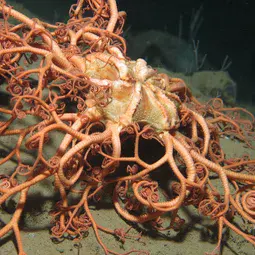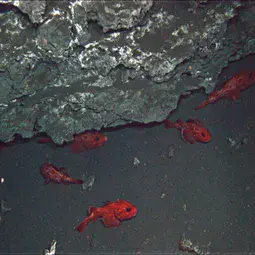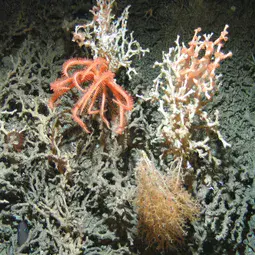From Finding Nemo to minerals – what riches lie in the deep sea?
As fishing and the harvesting of metals, gas and oil have expanded deeper and deeper into the ocean, scientists are drawing attention to the services provided by the deep sea, the world’s largest environment. “This is the time to discuss deep-sea stewardship before exploitation is too much farther underway,” says lead-author Andrew Thurber. In a review published today in Biogeosciences, a journal of the European Geosciences Union (EGU), Thurber and colleagues summarise what this habitat provides to humans, and emphasise the need to protect it.
“The deep sea realm is so distant, but affects us in so many ways. That’s where the passion lies: to tell everyone what’s down there and that we still have a lot to explore,” says co-author Jeroen Ingels of Plymouth Marine Laboratory in the UK.
“What we know highlights that it provides much directly to society,” says Thurber, a researcher at the College of Earth, Ocean and Atmospheric Sciences at Oregon State University in the US. Yet, the deep sea is facing impacts from climate change and, as resources are depleted elsewhere, is being increasingly exploited by humans for food, energy and metals like gold and silver.
“We felt we had to do something,” says Ingels. “We all felt passionate about placing the deep sea in a relevant context and found that there was little out there aimed at explaining what the deep sea does for us to a broad audience that includes scientists, the non-specialists and ultimately the policy makers. There was a gap to be filled. So we said: ‘Let’s just make this happen’.”
In the review of over 200 scientific papers, the international team of researchers points out how vital the deep sea is to support our current way of life. It nurtures fish stocks, serves as a dumping ground for our waste, and is a massive reserve of oil, gas, precious metals and the rare minerals we use in modern electronics, such as cell phones and hybrid-car batteries. Further, hydrothermal vents and other deep-sea environments host life forms, from bacteria to sponges, that are a source of new antibiotics and anti-cancer chemicals. It also has a cultural value, with its strange species and untouched habitats inspiring books and films from 20,000 Leagues Under the Sea to Finding Nemo.
“From jewellery to oil and gas and future potential energy reserves as well as novel pharmaceuticals, deep-sea’s worth should be recognised so that, as we decide how to use it more in the future, we do not inhibit or lose the services that it already provides,” says Thurber.
The deep sea (ocean areas deeper than 200m) represents 98.5% of the volume of our planet that is hospitable to animals. It has received less attention than other environments because it is vast, dark and remote, and much of it is inaccessible to humans. But it has important global functions. In the Biogeosciences review the team shows that deep-sea marine life plays a crucial role in absorbing carbon dioxide from the atmosphere, as well as methane that occasionally leaks from under the seafloor. In doing so, the deep ocean has limited much of the effects of climate change.
This type of process occurs over a vast area and at a slow rate. Thurber gives other examples: manganese nodules, deep-sea sources of nickel, copper, cobalt and rare earth minerals, take centuries or longer to form and are not renewable. Likewise, slow-growing and long-lived species of fish and coral in the deep sea are more susceptible to overfishing. “This means that a different approach needs to be taken as we start harvesting the resources within it.”
By highlighting the importance of the deep sea and identifying the traits that differentiate this environment from others, the researchers hope to provide the tools for effective and sustainable management of this habitat.
“This study is one of the steps in making sure that the benefits of the deep sea are understood by those who are trying to, or beginning to, regulate its resources,” concludes Thurber. “We ultimately hope that it will be a useful tool for policy makers.”
###
Please mention the name of the publication (Biogeosciences) if reporting on this story and, if reporting online, include a link to the paper (http://www.biogeosciences.net/11/3941/2014/bg-11-3941-2014.html) or to the journal website (http://www.biogeosciences.net/).
More information
The research was the result of a workshop at the International Research Institute of Stavanger in Norway, supported by INDEEP (the International Network for Scientific Investigations of Deep-Sea Ecosystems) through a grant awarded by the Total Foundation. The authors declare no competing interests and that the funding agency had no input into the content of their review article.
This research is presented in the paper ‘Ecosystem function and services provided by the deep sea’ to appear in the EGU open access journal Biogeosciences on 29 July 2014.
Full citation: Thurber, A. R., Sweetman, A. K., Narayanaswamy, B. E., Jones, D. O. B., Ingels, J., and Hansman, R. L.: Ecosystem function and services provided by the deep sea, Biogeosciences, 11, 3941-3963, doi:10.5194/bg-11-3941-2014, 2014.
The team is composed of A. R. Thurber (College of Earth, Ocean, and Atmospheric Sciences, Oregon State University, Corvallis, USA), A. K. Sweetman (International Research Institute of Stavanger, Randaberg, Norway), B. E. Narayanaswamy (Scottish Association for Marine Science, Scottish Marine Institute, Oban, UK), D. O. B. Jones (National Oceanography Centre, Southampton, UK), J. Ingels (Plymouth Marine Laboratory, UK), and R. L. Hansman (Department of Limnology and Oceanography, University of Vienna, Austria).
The European Geosciences Union (EGU) is Europe’s premier geosciences union, dedicated to the pursuit of excellence in the Earth, planetary, and space sciences for the benefit of humanity, worldwide. It is a non-profit interdisciplinary learned association of scientists founded in 2002. The EGU has a current portfolio of 16 diverse scientific journals, which use an innovative open access format, and organises a number of topical meetings, and education and outreach activities. Its annual General Assembly is the largest and most prominent European geosciences event, attracting over 11,000 scientists from all over the world. The meeting’s sessions cover a wide range of topics, including volcanology, planetary exploration, the Earth’s internal structure and atmosphere, climate, energy, and resources. The 2015 EGU General Assembly is taking place is Vienna, Austria from 12 to 17 April 2015. For information regarding the press centre at the meeting and media registration, please check http://media.egu.eu closer to the time of the conference.
If you wish to receive our press releases via email, please use the Press Release Subscription Form at http://www.egu.eu/news/subscribe/. Subscribed journalists and other members of the media receive EGU press releases under embargo (if applicable) 24 hours in advance of public dissemination.
Contact
Andrew Thurber
Assistant Professor (Senior Research), Ocean Ecology and Biogeochemistry
College of Earth, Ocean, and Atmospheric Sciences, Oregon State University
Corvallis, USA
Tel.: +1-541-737-4500
Email athurber@coas.oregonstate.edu
Jeroen Ingels
Postdoctoral Researcher, Marine Ecology
Plymouth Marine Laboratory
Plymouth, Devon, United Kingdom
Tel.: +44-1752-633-476
Email jein@pml.ac.uk
Bárbara Ferreira
EGU Media and Communications Manager
Munich, Germany
Phone +49-89-2180-6703
Email media@egu.eu
Links
- Scientific paper
- Journal – Biogeosciences
- Read this press release in simplified language, aimed at 7–13 year olds, on our Planet Press site





